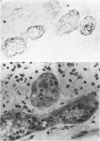Abstract
Monoclonal antibodies raised against and/or recognizing stage-specific antigens on preimplantation mouse embryos and stem cells of murine teratocarcinoma were used to localize these antigens immunohistochemically on human testicular germ cell tumors. SSEA-1, the antigen found on mouse embryonal carcinoma (EC) cells and embryonic cells from the 8-cell stage embryo onward, including the fetal primordial germ cells, was detected on yolk sac carcinoma components of human tumors, but not on EC cells. SSEA-3, the antigen found on follicular ova, fertilized eggs, early cleavage stage embryonic cells, and visceral endodermal cells of the mouse embryo, but not on mouse EC cells, was detected on human EC cells. Both antigens were found on the cell surface of fetal testicular germ cells but not in the seminiferous tubules of adult human testes. These data point out differences between human and murine EC cells suggesting that human EC cells correspond developmentally to a less mature embryonic cell than the murine EC cells. The possible histogenesis of human germ cell tumors from primordial and/or fetal germ cells is briefly discussed.
Full text
PDF

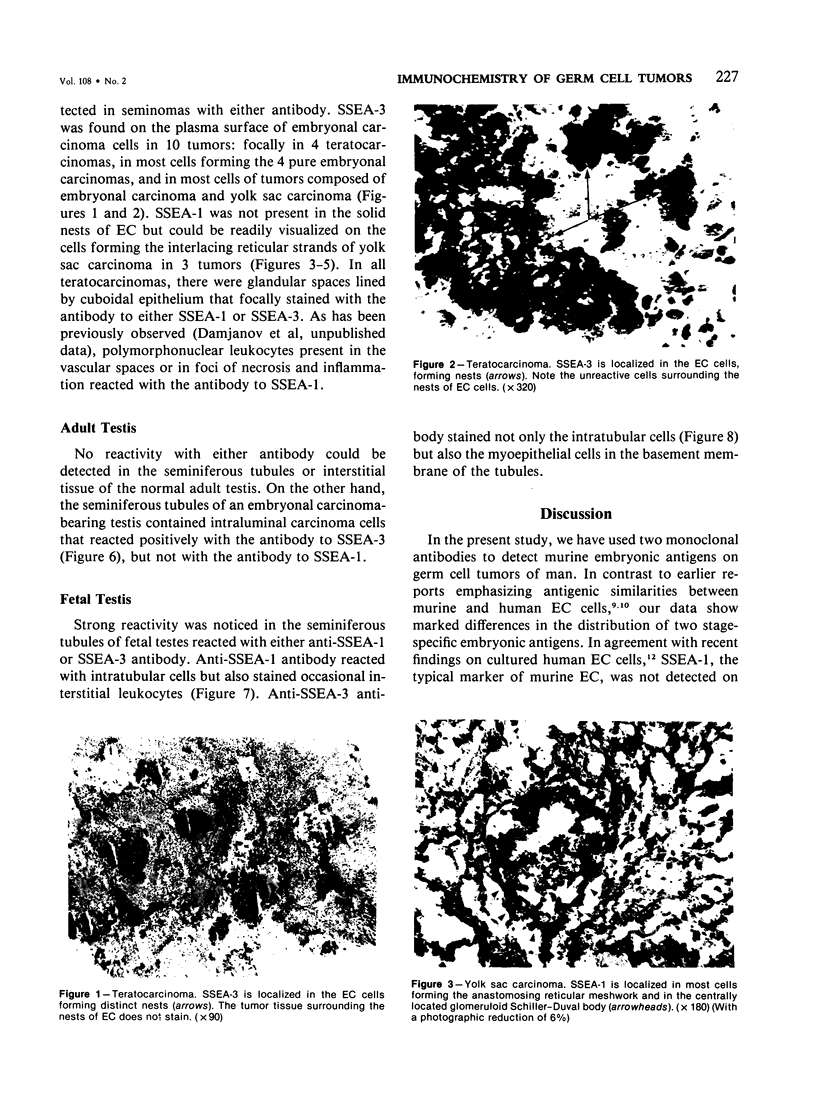
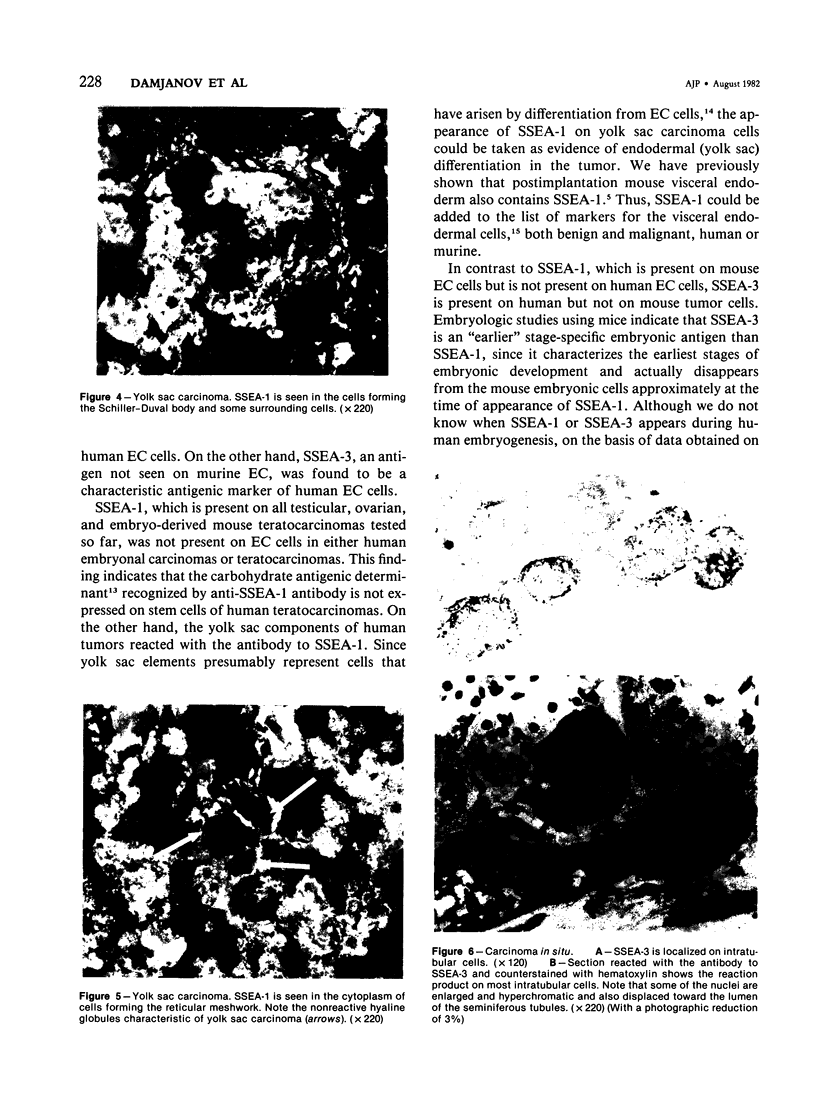
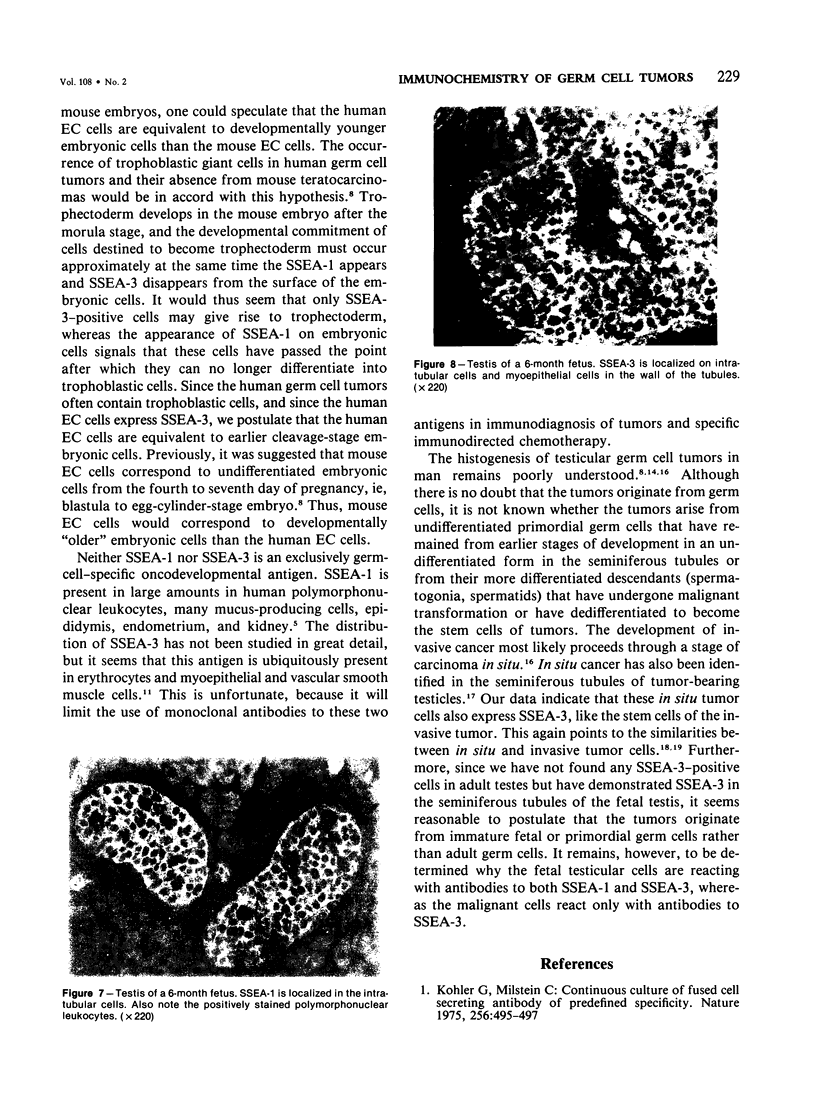
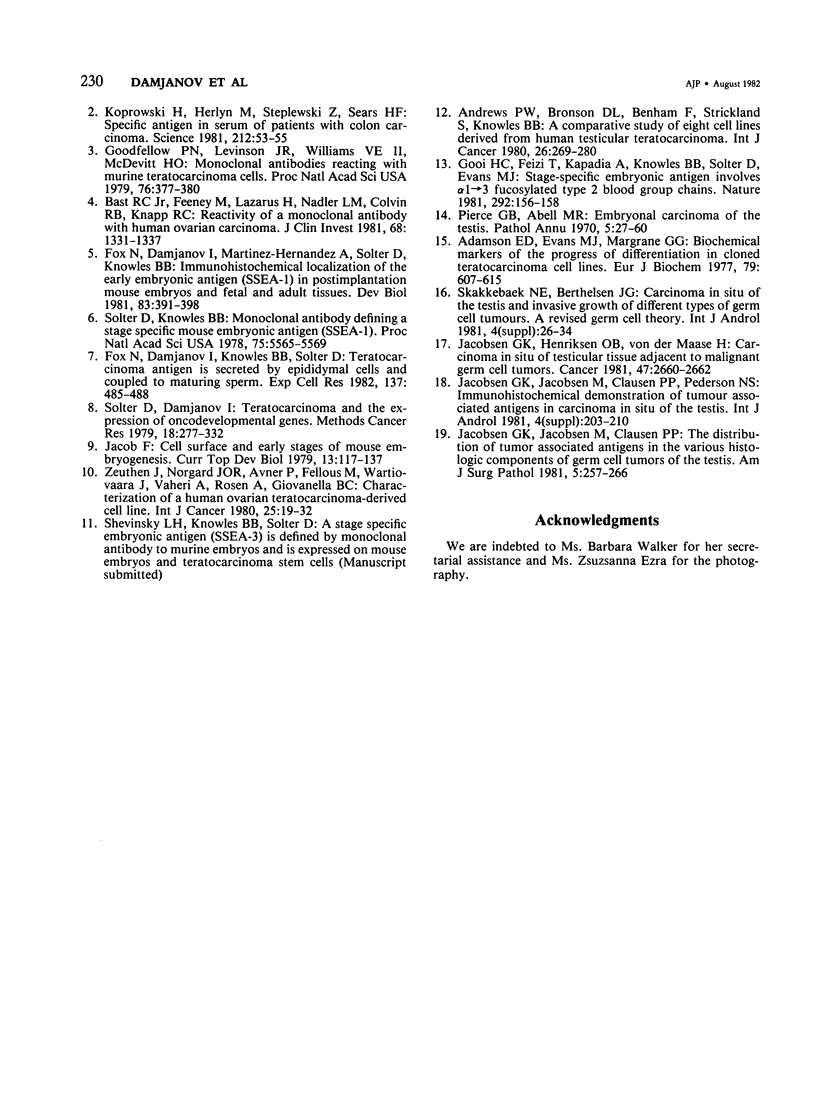
Images in this article
Selected References
These references are in PubMed. This may not be the complete list of references from this article.
- Adamson E. D., Evans M. J., Magrane G. G. Biochemical markers of the progress of differentiation in cloned teratocarcinoma cell lines. Eur J Biochem. 1977 Oct 3;79(2):607–615. doi: 10.1111/j.1432-1033.1977.tb11845.x. [DOI] [PubMed] [Google Scholar]
- Andrews P. W., Bronson D. L., Benham F., Strickland S., Knowles B. B. A comparative study of eight cell lines derived from human testicular teratocarcinoma. Int J Cancer. 1980 Sep 15;26(3):269–280. doi: 10.1002/ijc.2910260304. [DOI] [PubMed] [Google Scholar]
- Bast R. C., Jr, Feeney M., Lazarus H., Nadler L. M., Colvin R. B., Knapp R. C. Reactivity of a monoclonal antibody with human ovarian carcinoma. J Clin Invest. 1981 Nov;68(5):1331–1337. doi: 10.1172/JCI110380. [DOI] [PMC free article] [PubMed] [Google Scholar]
- Fox N., Damjanov I., Knowles B. B., Solter D. Teratocarcinoma antigen is secreted by epididymal cells and coupled to maturing sperm. Exp Cell Res. 1982 Feb;137(2):485–488. doi: 10.1016/0014-4827(82)90058-1. [DOI] [PubMed] [Google Scholar]
- Fox N., Damjanov I., Martinez-Hernandez A., Knowles B. B., Solter D. Immunohistochemical localization of the early embryonic antigen (SSEA-1) in postimplantation mouse embryos and fetal and adult tissues. Dev Biol. 1981 Apr 30;83(2):391–398. doi: 10.1016/0012-1606(81)90487-5. [DOI] [PubMed] [Google Scholar]
- Goodfellow P. N., Levinson J. R., Williams V. E., 2nd, McDevitt H. O. Monoclonal antibodies reacting with murine teratocarcinoma cells. Proc Natl Acad Sci U S A. 1979 Jan;76(1):377–380. doi: 10.1073/pnas.76.1.377. [DOI] [PMC free article] [PubMed] [Google Scholar]
- Gooi H. C., Feizi T., Kapadia A., Knowles B. B., Solter D., Evans M. J. Stage-specific embryonic antigen involves alpha 1 goes to 3 fucosylated type 2 blood group chains. Nature. 1981 Jul 9;292(5819):156–158. doi: 10.1038/292156a0. [DOI] [PubMed] [Google Scholar]
- Jacob F. Cell surface and early stages of mouse embryogenesis. Curr Top Dev Biol. 1979;13(Pt 1):117–137. doi: 10.1016/s0070-2153(08)60692-4. [DOI] [PubMed] [Google Scholar]
- Jacobsen G. K., Henriksen O. B., von der Maase H. Carcinoma in situ of testicular tissue adjacent to malignant germ-cell tumors: a study of 105 cases. Cancer. 1981 Jun 1;47(11):2660–2662. doi: 10.1002/1097-0142(19810601)47:11<2660::aid-cncr2820471123>3.0.co;2-6. [DOI] [PubMed] [Google Scholar]
- Jacobsen G. K., Jacobsen M., Clausen P. P. Distribution of tumor-associated antigens in the various histologic components of germ cell tumors of the testis. Am J Surg Pathol. 1981 Apr;5(3):257–266. doi: 10.1097/00000478-198104000-00006. [DOI] [PubMed] [Google Scholar]
- Koprowski H., Herlyn M., Steplewski Z., Sears H. F. Specific antigen in serum of patients with colon carcinoma. Science. 1981 Apr 3;212(4490):53–55. doi: 10.1126/science.6163212. [DOI] [PubMed] [Google Scholar]
- Köhler G., Milstein C. Continuous cultures of fused cells secreting antibody of predefined specificity. Nature. 1975 Aug 7;256(5517):495–497. doi: 10.1038/256495a0. [DOI] [PubMed] [Google Scholar]
- Pierce G. B., Abell M. R. Embryonal carcinoma of the testis. Pathol Annu. 1970;5:27–60. [PubMed] [Google Scholar]
- Solter D., Knowles B. B. Monoclonal antibody defining a stage-specific mouse embryonic antigen (SSEA-1). Proc Natl Acad Sci U S A. 1978 Nov;75(11):5565–5569. doi: 10.1073/pnas.75.11.5565. [DOI] [PMC free article] [PubMed] [Google Scholar]
- Zeuthen J., Nørgaard J. O., Avner P., Fellous M., Wartiovaara J., Vaheri A., Rosén A., Giovanella B. C. Characterization of a human ovarian teratocarcinoma-derived cell line. Int J Cancer. 1980 Jan 15;25(1):19–32. doi: 10.1002/ijc.2910250104. [DOI] [PubMed] [Google Scholar]








